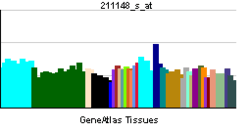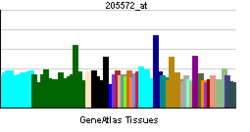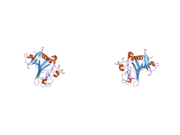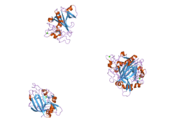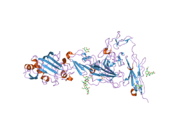ANGPT2
Angiopoietin-2 is a protein that in humans is encoded by the ANGPT2 gene.[1]
Naturally occurring antagonist for both ANGPT1 and TIE2; expressed only at the sites of vascular remodeling; similar to angiopoietin-1[2]
Interactions
ANGPT2 has been shown to interact with TEK tyrosine kinase.[3][4][5]
See also
References
- ↑ Cheung AH, Stewart RJ, Marsden PA (Jun 1998). "Endothelial Tie2/Tek ligands angiopoietin-1 (ANGPT1) and angiopoietin-2 (ANGPT2): regional localization of the human genes to 8q22.3-q23 and 8p23". Genomics 48 (3): 389–91. doi:10.1006/geno.1997.5207. PMID 9545648.
- ↑ "Entrez Gene: ANGPT2 angiopoietin 2".
- ↑ Fiedler, Ulrike; Krissl, Tanja; Koidl, Stefanie; Weiss, Cornelia; Koblizek, Thomas; Deutsch, Urban; Martiny-Baron, Georg; Marmé, Dieter; Augustin, Hellmut G (Jan 2003). "Angiopoietin-1 and angiopoietin-2 share the same binding domains in the Tie-2 receptor involving the first Ig-like loop and the epidermal growth factor-like repeats". J. Biol. Chem. (United States) 278 (3): 1721–7. doi:10.1074/jbc.M208550200. ISSN 0021-9258. PMID 12427764.
- ↑ Sato, A; Iwama A; Takakura N; Nishio H; Yancopoulos G D; Suda T (Aug 1998). "Characterization of TEK receptor tyrosine kinase and its ligands, Angiopoietins, in human hematopoietic progenitor cells". Int. Immunol. (ENGLAND) 10 (8): 1217–27. doi:10.1093/intimm/10.8.1217. ISSN 0953-8178. PMID 9723709.
- ↑ Maisonpierre, P C; Suri, C; Jones, P F; Bartunkova, S; Wiegand, S J; Radziejewski, C; Compton, D; McClain, J; Aldrich, T H; Papadopoulos, N; Daly, T J; Davis, S; Sato, T N; Yancopoulos, G D (Jul 1997). "Angiopoietin-2, a natural antagonist for Tie2 that disrupts in vivo angiogenesis". Science (United States) 277 (5322): 55–60. doi:10.1126/science.277.5322.55. ISSN 0036-8075. PMID 9204896.
Further reading
- Maruyama K, Sugano S (1994). "Oligo-capping: a simple method to replace the cap structure of eukaryotic mRNAs with oligoribonucleotides.". Gene 138 (1–2): 171–4. doi:10.1016/0378-1119(94)90802-8. PMID 8125298.
- Maisonpierre PC, Suri C, Jones PF et al. (1997). "Angiopoietin-2, a natural antagonist for Tie2 that disrupts in vivo angiogenesis". Science 277 (5322): 55–60. doi:10.1126/science.277.5322.55. PMID 9204896.
- Suzuki Y, Yoshitomo-Nakagawa K, Maruyama K et al. (1997). "Construction and characterization of a full length-enriched and a 5'-end-enriched cDNA library". Gene 200 (1–2): 149–56. doi:10.1016/S0378-1119(97)00411-3. PMID 9373149.
- Sato A, Iwama A, Takakura N et al. (1998). "Characterization of TEK receptor tyrosine kinase and its ligands, Angiopoietins, in human hematopoietic progenitor cells". Int. Immunol. 10 (8): 1217–27. doi:10.1093/intimm/10.8.1217. PMID 9723709.
- Tanaka S, Mori M, Sakamoto Y et al. (1999). "Biologic significance of angiopoietin-2 expression in human hepatocellular carcinoma". J. Clin. Invest. 103 (3): 341–5. doi:10.1172/JCI4891. PMC 407900. PMID 9927494.
- Valenzuela DM, Griffiths JA, Rojas J et al. (1999). "Angiopoietins 3 and 4: Diverging gene counterparts in mice and humans". Proc. Natl. Acad. Sci. U.S.A. 96 (5): 1904–9. doi:10.1073/pnas.96.5.1904. PMC 26709. PMID 10051567.
- Grosios K, Leek JP, Markham AF et al. (1999). "Assignment of ANGPT4, ANGPT1, and ANGPT2 encoding angiopoietins 4, 1 and 2 to human chromosome bands 20p13, 8q22.3→q23 and 8p23.1, respectively, by in situ hybridization and radiation hybrid mapping". Cytogenet. Cell Genet. 84 (1–2): 118–20. doi:10.1159/000015235. PMID 10343124.
- Procopio WN, Pelavin PI, Lee WM, Yielding NM (1999). "Angiopoietin-1 and -2 coiled coil domains mediate distinct homo-oligomerization patterns, but fibrinogen-like domains mediate ligand activity". J. Biol. Chem. 274 (42): 30196–201. doi:10.1074/jbc.274.42.30196. PMID 10514510.
- Kim I, Kim JH, Ryu YS et al. (2000). "Characterization and expression of a novel alternatively spliced human angiopoietin-2". J. Biol. Chem. 275 (24): 18550–6. doi:10.1074/jbc.M910084199. PMID 10766762.
- Mezquita J, Mezquita P, Montserrat P et al. (2000). "Genomic structure and alternative splicing of chicken angiopoietin-2". Biochem. Biophys. Res. Commun. 275 (2): 643–51. doi:10.1006/bbrc.2000.3345. PMID 10964717.
- Xu Y, Yu Q (2001). "Angiopoietin-1, unlike angiopoietin-2, is incorporated into the extracellular matrix via its linker peptide region". J. Biol. Chem. 276 (37): 34990–8. doi:10.1074/jbc.M103661200. PMID 11447223.
- Acker T, Beck H, Plate KH (2002). "Cell type specific expression of vascular endothelial growth factor and angiopoietin-1 and -2 suggests an important role of astrocytes in cerebellar vascularization". Mech. Dev. 108 (1–2): 45–57. doi:10.1016/S0925-4773(01)00471-3. PMID 11578860.
- Ward EG, Grosios K, Markham AF, Jones PF (2002). "Genomic structures of the human angiopoietins show polymorphism in angiopoietin-2". Cytogenet. Cell Genet. 94 (3–4): 147–54. doi:10.1159/000048807. PMID 11856872.
- Huang YQ, Li JJ, Hu L et al. (2002). "Thrombin induces increased expression and secretion of angiopoietin-2 from human umbilical vein endothelial cells". Blood 99 (5): 1646–50. doi:10.1182/blood.V99.5.1646. PMID 11861279.
- Hata K, Udagawa J, Fujiwaki R et al. (2002). "Expression of angiopoietin-1, angiopoietin-2, and Tie2 genes in normal ovary with corpus luteum and in ovarian cancer". Oncology 62 (4): 340–8. doi:10.1159/000065066. PMID 12138242.
- Lin S, Shyu KG, Lee CC et al. (2002). "Hyperbaric oxygen selectively induces angiopoietin-2 in human umbilical vein endothelial cells". Biochem. Biophys. Res. Commun. 296 (3): 710–5. doi:10.1016/S0006-291X(02)00924-5. PMID 12176040.
- Geva E, Ginzinger DG, Zaloudek CJ et al. (2002). "Human placental vascular development: vasculogenic and angiogenic (branching and nonbranching) transformation is regulated by vascular endothelial growth factor-A, angiopoietin-1, and angiopoietin-2". J. Clin. Endocrinol. Metab. 87 (9): 4213–24. doi:10.1210/jc.2002-020195. PMID 12213874.
- Strausberg RL, Feingold EA, Grouse LH et al. (2003). "Generation and initial analysis of more than 15,000 full-length human and mouse cDNA sequences". Proc. Natl. Acad. Sci. U.S.A. 99 (26): 16899–903. doi:10.1073/pnas.242603899. PMC 139241. PMID 12477932.
- Paradis V, Bièche I, Dargère D et al. (2003). "A quantitative gene expression study suggests a role for angiopoietins in focal nodular hyperplasia". Gastroenterology 124 (3): 651–9. doi:10.1053/gast.2003.50104. PMID 12612904.
PDB gallery |
|---|
| | 1z3s: Angiopoietin-2 Receptor Binding Domain |
| 1z3u: Structure of the Angiopoietin-2 Recptor Binding Domain and Identification of Surfaces Involved in Tie2 Recognition |
| 2gy7: Angiopoietin-2/Tie2 Complex Crystal Structure |
|
|
|
This article incorporates text from the United States National Library of Medicine, which is in the public domain.
|
|---|
| | Endogenous Regulation | |
|---|
| | Exogenous Regulation | |
|---|
| | See also | |
|---|
|
|
|---|
| | angiogenic | |
|---|
| | anti-angiogenic | |
|---|
| | | |
|---|
| | Description |
- Anatomy
- Arteries
- head and neck
- arms
- chest
- abdomen
- legs
- Veins
- head and neck
- arms
- chest
- abdomen and pelvis
- legs
- Development
- Cells
- Physiology
|
|---|
| | Disease |
- Congenital
- Neoplasms and cancer
- Lymphatic vessels
- Injury
- Vasculitis
- Other
- Symptoms and signs
|
|---|
| | Treatment |
- Procedures
- Drugs
- beta blockers
- channel blockers
- diuretics
- nonsympatholytic vasodilatory antihypertensives
- peripheral vasodilators
- renin–angiotensin system
- sympatholytic antihypertensives
- vasoprotectives
|
|---|
|
|

